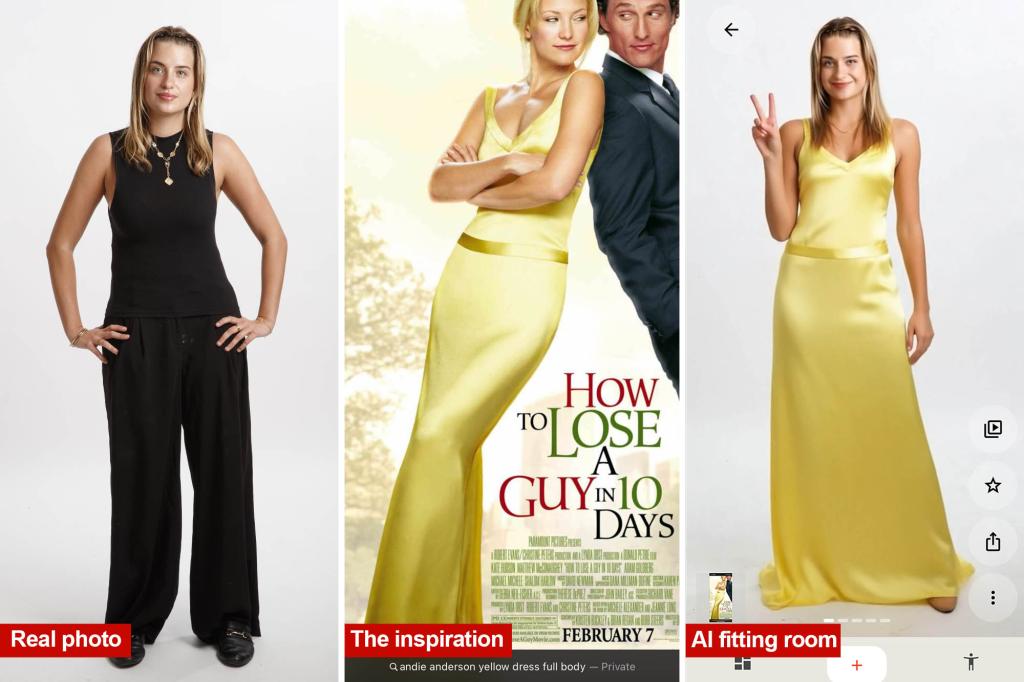I wasn’t planning to try on Kate Hudson’s yellow “How to Lose a Guy in 10 Days” dress from my office desk this week.
But that’s what happened when I downloaded Doppl, Google’s new AI fashion experiment that lets users virtually try on any outfit. Think Alicia Silverstone’s digital closet in “Clueless” — but AI, and on your phone.
All you have to do is snap a full-body photo of yourself, upload the outfit you want to try and, within 30 to 60 seconds, your digital twin shows up wearing it.
It’s meant to replace your dressing room. So naturally, I gave it a shot.
My “Doppl” — unsettlingly similar to me, but with slightly-off proportions and longer hair — stood in the iconic yellow gown I’ve been obsessed with since middle school. Then it waved.
Each animation is different. The app can create short videos of your AI clone moving in the outfit, usually with a slow turn or stiff pose. In this case, mine lifted an arm and posed like she was headed to the Oscars.
It was jarring. But I couldn’t stop watching. The fit wasn’t exact, but it was more accurate than I expected and enough to make me genuinely want the dress. Maybe need it.
Doppl, launched last week through Google Labs, is part try-on tool, part tech experiment. Users can upload photos of outfits — whether it’s a Pinterest fit, something from your favorite store’s website or a sweater you spotted at a thrift shop — and the app creates a virtual version of you in the outfit.
You can also skip using your own photo and choose from 20 preset AI models of different ages, races and body types.
For now, Google says Doppl “might not always get things right.” The app only supports tops, bottoms and dresses — no shoes, bags or accessories — and doesn’t offer sizing advice or help with fit.
Still, I wanted to see what it could do.
One outfit I tested came from my Pinterest board — titled “The Life of a Shopping Addict” — basically a running digital wish list of clothes I wish I owned. I picked a Saturday-night look: a black tank top and long, flowy skirt.
Doppl gave me a short black mini dress and black boots that looked nothing like it. In some photos, it even added a few inches to my hair.
Other outfits fared better. I uploaded a pair of jeans from Zara that had been sitting in my cart, and Doppl surprised me by generating an image that included the belt from the product photo, even though Google said accessories aren’t yet supported.
The rendering wasn’t perfect, but as someone who’s 5’10” and struggles to find jeans that are long enough online, it looked good enough.
I bought them.
From what I’ve seen, simpler outfits work best. The AI struggles with complex silhouettes — layered looks, blurry images, tricky fabrics — and occasionally invents new clothes from scratch if it can’t figure things out. When it works, it’s persuasive.
When it doesn’t, you’re watching a glitchy clone wear something you didn’t ask for.
“This is generative AI in an augmented reality format,” said Sucharita Kodali, a retail analyst at Forrester. “I can’t imagine that it wouldn’t be useful. Is it going to be transformational and double anybody’s business? No. But it’ll be useful.”
The app isn’t perfect. Doppl skips over personalized questions like your height or measurements, which could make try-ons more accurate. You also have to be over 18, live in the U.S. and be logged into your Google account to use it.
While it may not be replacing store dressing rooms anytime soon, for a free app on your phone, it gets surprisingly close. And it might just talk you into buying something you already wanted anyway.
Read the full article here


